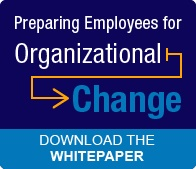Alan Watts, the British born philosopher, writer and speaker once said, “The only way to make sense out of change is to plunge into it, move with it, and join the dance”. Easier said than done, right? In a perfect world, everyone would love change. We could just send out an email announcing a change, and people would jump in with both feet, no questions asked—there would be no resistance and no complaining. 
The reality, though, is most people, other than perhaps a wet baby, really don’t like change. Personal transition requires sacrifice, adopting new attitudes, and abandoning ingrained habits; none of these are easily done. When change goes unmanaged, it can cause stress, anxiety, and pain.
So, how can you prepare your employees for the change dance? We get that question a lot. And luckily we have an answer. In reality, the dynamics of change are quite predictable. Preparing individuals for what to expect when dealing with change goes a long way toward giving them a sense of control over their environment.
In our many years of change management consulting experience, we have found that during any change, employees need to be able to:
- describe the nature of the change in order to know in advance what is likely to occur,
- recognize emotional patterns in themselves and other around them, and,
- take personal responsibility for the parts of the change that they can control
Over the next few weeks our blog articles will take a closer look at these three challenges for making a personal transition.
- How to stay Productive
- How to remain Professional
- What individuals can do to Be Proactive
The 3 Personal Transition Challenges
The first challenge of personal transition is to stay productive when change is swirling all around. The dynamics of change function much like gravity. The status quo exerts a strong force that pulls people back to the old ways of doing things. In order to stay productive during a change, individuals have to escape the gravitational pull of these seven transitional dynamics:
- The Emotional Roller Coaster – Emotions will shift at various points in the implementation, and will also vary from person to person. Helping employees anticipate and self-recognize their own journey on the roller coaster of emotion is the first step an employee must take in order to deal with the change.
- The Letting Go Dilemma –Anybody going through a change needs to ask, “What must I give up or let go of in order to make this change?”. People have to be able to mourn their losses before they can let go. In other words, there must be an ending, before there can be a new beginning.
- The Me Factor – “What’s in it for me?” is one of the most important questions that must be asked during a change. An individual can’t begin to move forward until there is a personal answer to this powerful “me” question.
- The Stress of Future Shock – ‘Future shock’ is defined as too much stress in too short of time. Often times getting through a change is seen as just one item in a long to-do list. Helping individuals identify their work priorities is a crucial step in remaining productive during a transition.
- The Individual Experience of a Group Event – Not everyone will react to change in the same way. Some individuals will adapt quickly, while others will take their time to change their behavior. Encouraging tolerance to other peoples’ reactions will go a long way toward helping individuals ready themselves for a change.
- Previous Experiences – Past experience is a huge predictor of future action. If change hasn’t gone well in the past, why would people think this time will be different?
- Strength of Habit – An individual won’t be motivated to change until the perceived pain of staying in the status quo is greater than the pain of changing. The reality is that when the pressure is off, people will always revert back to their old way of doing things, unless there are consequences and rewards that motivate them to change.
If we recognize these seven dynamics that have the power to pull individuals back to the status quo, and put tactics in place to deal with them, we can help the workforce remain productive during an organizational change.
Next week, we will look at the challenge of remaining professional during a change. In the meantime, now would be a good time to ask yourself, are your employees ready to join the dance on your change?


